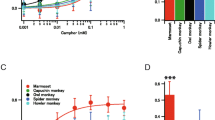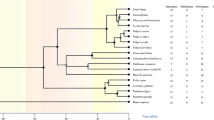Abstract
Bitter taste perception enables the detection of potentially toxic molecules and thus evokes avoidance behavior in vertebrates. It is mediated by bitter taste receptors, TAS2Rs. One of the best-studied TAS2R is TAS2R38. Phenylthiocarbamide (PTC) perception and TAS2R38 receptors vary across primate species, and this variation may be related to variation in dietary preferences. In particular, we previously found that the low sensitivity of TAS2R38s in Asian colobines likely evolved as an adaptation to their leaf-eating behavior. However, it remains unclear whether this low PTC sensitivity is a general characteristic of the subfamily Colobinae, a primate group that feeds predominantly on leaves. We performed genetic analyses, functional assays with mutant proteins, and behavioral analyses to evaluate the general characteristics of TAS2R38 in colobines. We found that PTC sensitivity is lower in TAS2R38s of African colobines than in TAS2R38s of omnivorous macaques. Furthermore, two amino acids shared between Asian and African colobines were responsible for low sensitivity to PTC, suggesting that the last common ancestor of extant colobines had this phenotype. We also detected amino acid differences between TAS2R38s in Asian and African colobines, indicating that they evolved independently after the separation of these groups.





Similar content being viewed by others
References
Anderson J (2005) Habitat fragmentation and metapopulation dynamics of the Angola black-and-white colobus (Colobus angolensis palliatus) in coastal Kenya. In: Dissertation, University College London.
Ames BN, Profet M, Gold LS (1990) Nature’s chemicals and synthetic chemicals: comparative toxicology. Proc Natl Acad Sci 87:7782–7786
Biarnes X, Marchiori A, Giorgetti A, Lanzara C, Gasparini P, Carloni P, Born S, Brockhoff A, Behrens M, Meyerhof W (2010) Insights into the binding of phenyltiocarbamide (PTC) agonist to its target human TAS2R38 bitter receptor. PLoS One 5(8):e12394. https://doi.org/10.1371/journal.pone.0012394
Bocian (1997) Niche separation of black-and-white colobus (Colobus angolensis and C. guereza) in the Ituri forest. In: Dissertation, City University of New York
Campbell MC, Ranciaro A, Froment A, Hirbo J, Omar S, Bodo JM, Nyambo T, Lema G, Zinshteyn D, Drayna D, Breslin PAS, Tishkoff SA (2012) Evolution of functionally diverse alleles associated with PTC bitter taste sensitivity in Africa. Mol Biol Evol 29:1141–1153. https://doi.org/10.1093/molbev/msr293
Caton JM (1999) Digestive strategy of the Asian colobine genus Trachypithecus. Primates 40:311–325
Chiarelli B (1963) Sensitivity to PTC (phenyl-thio-carbamide) in primates. Folia Primatol 1:88–94
Dunham NT (2017) Feeding ecology and dietary flexibility of Colobus angolensis palliatus in relation to habitat disturbance. Int J Primatol 38(3):553–557
Fashing PJ, Dierenfeld ES, Mowry CB (2007) Influence of plant and soil chemistry on food selection, ranging patterns, and biomass of Colobus guereza in Kakamega Forest, Kenya. Int J Primatol 28(3):673–703. https://doi.org/10.1007/s10764-006-9096-2
Fashing PJ, Forrestel A, Scully C, Cords M (2004) Long-term tree population dynamics and their implications for the conservation of the Kakamega Forest, Kenya. Biodivers Conserv 13:753–771
Hayakawa T, Sugawara T, Go Y, Udono T, Hirai H, Imai H (2012) Eco-geographical diversification of bitter taste receptor genes (TAS2Rs) among subspecies of chimpanzees (Pan troglodytes). PLoS One 7:e43277. https://doi.org/10.1371/journal.pone.0043277
Hayakawa T, Suzuki-Hashido N, Matsui A, Go Y (2014) Frequent expansions of the bitter taste receptor gene repertoire during evolution of mammals in the Euarchontoglires clade. Mol Biol Evol 31:2018–2031
Kim UK, Jorgenson E, Coon H, Leppert M, Risch N, Drayna D (2003) Positional cloning of the human quantitative trait locus underlying taste sensitivity to phenylthiocarbamide. Science 299:1221–1225. https://doi.org/10.1126/science.1080190
Komane BM, Olivier EI, Viljoen AM (2011) Trichilia emetica (Meliaceae)—a review of traditional uses, biological activities and phytochemistry. Phytochem Lett 4:1–9
Lambert JE (1998) Primate digestion: interactions among anatomy, physiology, and feeding ecology. Evol Anthropol 7:8–20
Marchiori A, Capece L, Giorgetti A, Gasparini P, Behrens M, Carloni P, Meyerhof W (2013) coarse-grained/molecular mechanics of the TAS2R38 bitter taste receptor: experimentally-validated detailed structural prediction of agonist binding. PLoS One 8(5):e64675. https://doi.org/10.1371/journal.pone.0064675
Meyerhof W (2005) Elucidation of mammalian bitter taste. Rev Physiol Biochem Pharmacol 154:37–72. https://doi.org/10.1007/s10254-005-0041-0
Meyerhof W, Batram C, Kuhn C, Brockhoff A, Chudoba E, Bufe B, Appendino G, Behrens M (2010) the molecular receptive ranges of human TAS2R bitter taste receptors. Chem Senses 35:157–170. https://doi.org/10.1093/chemse/bjp092
Newcombe RG (2016) Interval estimation for the difference between independent proportions: comparison of eleven methods. Statist Med 17:873–890
Oates JF (1977) The guereza and its food. In: Clutton-Brock TH (ed) Primate ecology. Academic Press, New York, pp 275–321
Oates JF (1978) Water-plant and soil consumption by guereza monkeys (Colobus guereza): a relationship with minerals and toxins in the diet. Biotropica 1978:241–253
Pan R (2006) Dental morphometric variation between African and Asian colobines, with special reference to the other Old World monkeys. J Morphol 267:1087–1098. https://doi.org/10.1002/jmor.10463
Purba LHPS, Widayati KA, Tsutsui K, Suzuki-Hashido N, Hayakawa T, Nila S, Suryobroto B, Imai H (2017) Functional characterization of the TAS2R38 bitter taste receptor for phenylthiocarbamide in colobine monkeys. Biol Lett 13:20160834. https://doi.org/10.1098/rsbl.2016.0834
Ritz C, Baty F, Streibig JC, Gerhard D (2015) Dose-response analysis using R. PLoS One 10:e0146021. https://doi.org/10.1371/journal.pone.0146021
Roos C, Zinner D, Kubatko L, Schwarz C, Yang M, Meyer D, Nash SD, Xing J, Batzer MA, Brameier M, Leenderzt FH, Ziegler T, Perwitasari-Farajallah D, Nadler T, Walter L, Osterholz M (2011) Nuclear versus mitochondrial DNA: evidence for hybridization in colobine monkeys. BMC Evol Biol 11:77
Roy A, Saraf S (2005) Limonoids: overview of significant bioactive triterpenes distributed in plants kingdom. Biol Pharm Bull 29(2):191–201
Stewart CB, Disotell TR (1998) Primate evolution: in and out of Africa. Curr Biol 8:582–588
Suzuki N, Sugawara T, Matsui A, Go Y, Hirai H, Imai H (2010) Identification of non-taster Japanese macaques for a specific bitter taste. Primates 51:285–289. https://doi.org/10.1007/s10329-010-0209-3
Suzuki-Hashido N, Hayakawa T, Matsui A, Go Y, Ishimaru Y, Misaka T, Abe K, Hirai H, Satta Y, Imai H (2015) Rapid expansion of phenylthiocarbamide non-tasters among Japanese macaques. PLoS One 10:e0132016. https://doi.org/10.1371/journal.pone.0132016
Ting N, Tosi AJ, Li Y, Zhang Y-P, Disotell TR (2008) Phylogenetic incongruence between nuclear and mitochondrial markers in the Asian colobines and the evolution of the langurs and leaf monkeys. Mol Phylogenet Evol 46(2):466–474. https://doi.org/10.1016/j.ympev.2007.11.008
Tsuji Y, Mitani M, Widayati KA, Suryobroto B, Watanabe K (2019) Dietary habits of wild Javan lutungs (Trachypithecus auratus) in a secondary-plantation mixed forest: effects of vegetation composition and phenology. Mamm Biol 98:80–90. https://doi.org/10.1016/j.mambio.2019.08.001
Ueda T, Ugawa S, Yamamura H, Imaizumi Y, Shimada S (2003) Functional interaction between T2R taste receptors and G-protein α subunits expressed in taste receptor cells. J Neurosci 23:7376–7380
Vaidehi N, Floriano WB, Trabanino R, Hall SE, Freddolino P, Choi EJ, Zamanakos G, Goddard WA (2002) Prediction of structure and function of G protein-coupled receptors. Proc Natl Acad Sci 99:12622–12627. https://doi.org/10.1073/pnas.122357199
Wang XP, Yu L, Roos C, Ting N, Chen CP, Wang J, Zhang YP (2012) Phylogenetic relationships among the colobine monkeys revisited: new insights from analyses of complete mt genomes and 44 nuclear non-coding markers. PLoS One 7(4):e36274. https://doi.org/10.1371/journal.pone.0036274
Widayati KA, Yan X, Suzuki-Hashido N, Itoigawa A, Purba LHPS, Fahri F, Terai Y, Suryobroto B, Imai H (2019) Functional divergence of the bitter receptor TAS2R38 in Sulawesi macaques. Ecol Evol 00:1–7. https://doi.org/10.1002/ece3.5557
Wong SKF (2003) G protein selectivity is regulated by multiple intracellular regions of GPCR. Neurosignals 12:1–12. https://doi.org/10.1159/000068914
Wooding S, Bufe B, Grassi C, Howard MT, Stone AC, Vazquez M, Dunn DM, Meyerhof W, Weiss RB, Bamshad MJ (2006) Independent evolution of bitter-taste sensitivity in humans and chimpanzees. Nature 440:930–934. https://doi.org/10.1038/nature04655
Wooding S, Gunn H, Ramos P, Thalmann S, Xing C, Meyerhof W (2010) Genetics and bitter taste responses to goitrin, a plant toxin found in vegetables. Chem Senses 35(8):685–692
Zhang J (2006) Parallel adaptive origins of digestive RNases in Asian and African leaf monkeys. Nat Genet 38:819–823. https://doi.org/10.1038/ng1812
Zhang Y, Ryder OA (1998) Mitochondrial cytochrome b gene sequences of Old World Monkeys: with special reference on evolution of Asian Colobines. Primates 39:39–49. https://doi.org/10.1007/BF02557742
Acknowledgements
The authors would like to thank Dr. Takashi Ueda, Dr. Yoshiro Ishimaru, Dr. Takumi Misaka, and Dr. Keiko Abe for providing the Ga16/gust44 and pEAK10 vectors, as well as Dr. Hiroaki Matsunami for providing HEK293T cells. We also wish to express our gratitude to Yumi Tsujiuchi, Taiki Okumura, and other keepers and veterinarians at the Japan Monkey Centre for taking care of the colobines, supporting behavioral assays, and collecting genetic samples, as well as Atsushi Yamanaka and the Center for Human Evolution Modeling Research at the Primate Research Institute, Kyoto University for taking care of the Japanese macaques. This study was funded by JSPS KAKENHI (#16H01338, #15H02421, #18H0400, and #19K21586 to HI; #16K18630 to TH; and #17K15203 to NSH); research grants from the Kobayashi International Scholarship Foundation (to HI); PMDSU nos. 1050/IT3.11/LT/2017 and 1486/IT3.11/PN/2018 and nos. 219.6/D3/PG/2019, 121/SP2H/LT/DRPM/2019 from the Ministry of Research, Technology and Higher Education to BS; Cooperative Research Programme of Kyoto University (Kyodo Riyo Theme nos. 2017-B-51, 2018-B-35, 2019-B-55 and Sandwich-like PMDSU No: 1056/D3.2/PG/2018 to LHPSP). This work was also supported by JSPS and DG-RSTHE under the Japan-Indonesia Research Cooperative Program and Core-to-Core Program.
Author information
Authors and Affiliations
Contributions
LHPSP conducted the experiments, wrote the first draft, and analyzed and interpreted the data. KAW conducted the experiments, analyzed and interpreted data, and revised the manuscript. NSH and TH conducted the experiments, analyzed the data, and revised the draft. AI analyzed the data and revised the draft. SN collected samples. BJ analyzed the data and revised the draft. BS designed the experiments, and revised the manuscript. HI designed the experiments, and wrote the final draft. All authors agree to be held accountable for the content in the manuscript and approve the final version.
Corresponding authors
Ethics declarations
Ethical approval
Colobine behavioral assays were conducted at the Japan Monkey Centre, Inuyama, Japan. The study was approved by the Research Ethics Committee of the Japan Monkey Centre in accordance with the Ethical Guidelines for Research of the institution (April 1, 2016) as Collaborative Research with the Japan Monkey Centre (#2018015). The Japanese macaque assay was conducted at the Primate Research Institute, Kyoto University. Both experiments were approved by the Animal Welfare and Animal Care Committee of Primate Research Institute, Kyoto University (#2018–201) and were conducted in compliance with the Guidelines for Care and Use of Nonhuman Primates of the Primate Research Institute, Kyoto University (Version 3, issued in 2010). These guidelines were prepared based on the provisions of the Guidelines for Proper Conduct of Animal Experiments (June 1, 2006; Science Council of Japan), Basic Policies for the Conduct of Animal Experiments in Research Institutions under the Jurisdiction of the Ministry of Health, Labour and Welfare (effective on June 1, 2006; Ministry of Health, Labour and Welfare), Fundamental Guidelines for Proper Conduct of Animal Experiment and Related Activities in Academic Research Institutions (Notice No. 71 of the Ministry of Education, Culture, Sports, Science and Technology dated June 1, 2006), and Standards Relating to the Care and Management of Laboratory Animals and Relief of Pain (Notice No. 88 of the Ministry of the Environment dated April 28, 2006).
Additional information
Publisher's Note
Springer Nature remains neutral with regard to jurisdictional claims in published maps and institutional affiliations.
Electronic supplementary material
Below is the link to the electronic supplementary material.
About this article
Cite this article
Purba, L.H.P.S., Widayati, K.A., Suzuki-Hashido, N. et al. Evolution of the bitter taste receptor TAS2R38 in colobines. Primates 61, 485–494 (2020). https://doi.org/10.1007/s10329-020-00799-1
Received:
Accepted:
Published:
Issue Date:
DOI: https://doi.org/10.1007/s10329-020-00799-1




